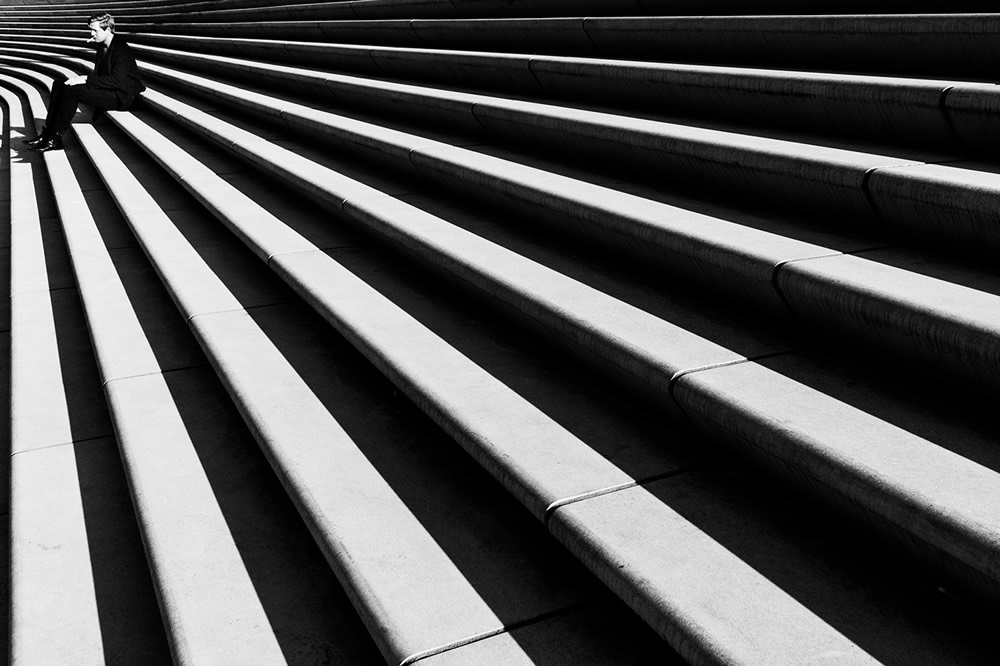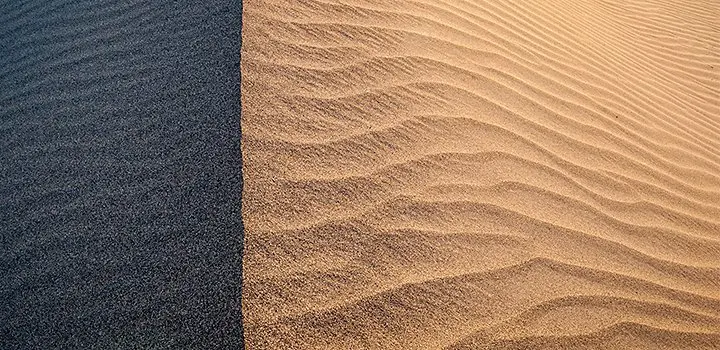What are the formal elements of Photography? It is the six traits – line, shape, pattern, texture, tone, focus – that, maybe not all, but would definitely be consisted in a photograph. A photo can include as many elements in it and could just have one element in it. For example, you could just capture a focused or not photograph of pure white and nothing else – it still has the element focus in it but without any other elements.
Line is literally what it is, a line or lines that either intertwine or exist on their own – it is often used to emphasize a certain object. Furthermore, by using lines, you could use them to emphasize or to create direction towards an object. For example, the image below uses stairs as a way to emphasize and create direction towards the person sitting. Additionally, it could also be used to create a focus point – all the lines below point toward one single direction, and because of the proportion, it grabs the viewer’s attention.

Shape is when a group of lines works together to create a geometrical shape; it often occurs with repetitions/patterns as it then becomes a group of shapes. In the image below, it uses shapes in different positions and postures as the subject of the photo. In fact, shapes are often used as the subject of the photo because they exist almost everywhere, and their size/physical traits often allow them to become the center of attention.

Pattern, aka repetition, is when a group of shapes is put together to generate a pattern. Patterns can make the photo feel structured and organized, thus generating an overall peaceful, stable mood. In the image below, the pattern creates a strong construction of systems of layers and evokes a stable, structured feeling in the viewers.

Texture is adding visual elements of color, depth, and shape. It can convince the viewer of the material on the surface of the photograph and make the viewer feel as if they are in the situation. In the photo below, because of the focus and the clarity of the photo, you can imagine what the sand touches, feels like, and is probably shaped like.

Tone is to create light-dark differences in a picture. It either emphasizes strong darkness vs. weak lighting or strong lighting vs. weak darkness, but it could also be just dark vs. light. In the picture below, the tone was used to emphasize the mountain in the middle – the surroundings and corners are all dark, and in the center, where the mountain is at, is the brightest. The hierarchy created by tone creates a strong contrast between its subject and its object.

Focus is to blur everything, or focus on everything, or to focus on mainly one thing and blur the rest. It’s often used to create focus points and hierarchy – or to blend the colors and subject together. In the picture below, focus is used to create a hierarchy on the toy bus and blur the background. Focus is also used here to blend the colors of the light and the colors of the objects – such as the cars and trees… – together, creating a glorious background view to set off its subject, the toy bus.

Citations:
Stripes And Lines: Street Photography Series By Alexander Schoenberg
“Thumbnails Exploring the Use of: LINE, POINT, SHAPE, FORM, SCALE, PATTERN, COMPOSITION, CONTRAST, TEXTURE Etc.” Connor Rankine, 29 Aug. 2014, connorrankine.wordpress.com/2014/08/29/thumbnails-exploring-the-use-of-line-point-shape-form-scale-pattern-composition-contrast-texture-etc.
dezeen.com/2014/03/22/alexander-jacques-photographs-abstract-architectural-patterns/
adobe.com/creativecloud/photography/discover/abstract-photography.html
visualwilderness.com/post-processing/using-tonal-contrast-better-bw-photography
greatbigphotographyworld.com/focus-modes/
Leave a Reply
You must be logged in to post a comment.